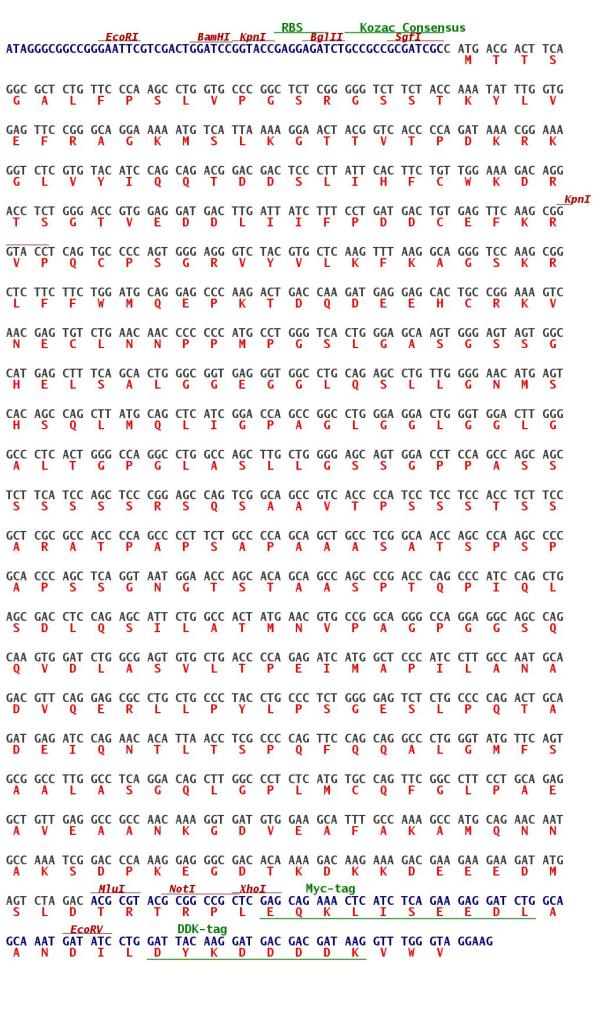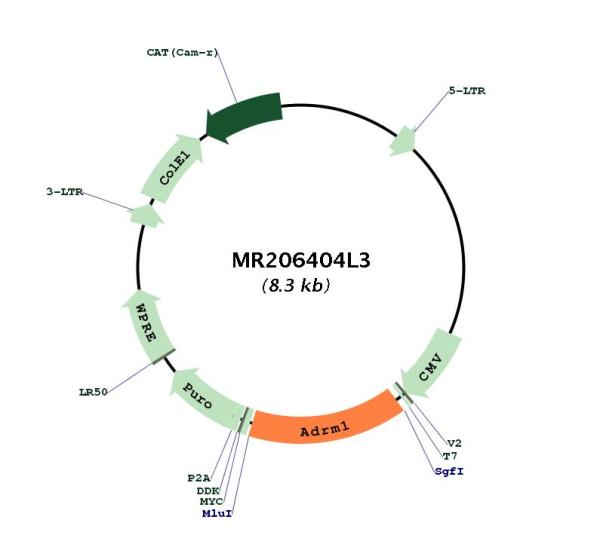Adrm1 (NM_019822) Mouse Tagged Lenti ORF Clone
SKU
MR206404L3
Lenti ORF clone of Adrm1 (Myc-DDK-tagged) - Mouse adhesion regulating molecule 1 (Adrm1)
-
LentiORF®
LentiORF®
Expression-ready ORF plasmid in lenti backbone
Click here to learn more.
| Product Data | |
| Type | Mouse Tagged ORF Clone |
|---|---|
| Target Symbol | Adrm1 |
| Synonyms | 1110063P18Rik; 2510006J17Rik; AA408205; ARM-1; Arm1; AU043535; Gp110; Rpn13 |
| Vector | pLenti-C-Myc-DDK-P2A-Puro |
| E. coli Selection | Chl (34 ug/mL) |
| Mammalian Cell Selection | Puromycin |
| Sequence Data |
ORF Nucleotide Sequence
The ORF insert of this clone is exactly the same as(MR206404).
|
| Restriction Sites |
SgfI-MluI Cloning Scheme for this gene
Plasmid Map

|
| ACCN | NM_019822 |
| ORF Size | 1221 bp |
| OTI Disclaimer | The molecular sequence of this clone aligns with the gene accession number as a point of reference only. However, individual transcript sequences of the same gene can differ through naturally occurring variations (e.g. polymorphisms), each with its own valid existence. This clone is substantially in agreement with the reference, but a complete review of all prevailing variants is recommended prior to use. More info |
| OTI Annotation | This clone was engineered to express the complete ORF with an expression tag. Expression varies depending on the nature of the gene. |
| Components | The ORF clone is ion-exchange column purified and shipped in a 2D barcoded Matrix tube containing 10ug of transfection-ready, dried plasmid DNA (reconstitute with 100 ul of water). |
| Reconstitution Method | 1. Centrifuge at 5,000xg for 5min. 2. Carefully open the tube and add 100ul of sterile water to dissolve the DNA. 3. Close the tube and incubate for 10 minutes at room temperature. 4. Briefly vortex the tube and then do a quick spin (less than 5000xg) to concentrate the liquid at the bottom. 5. Store the suspended plasmid at -20°C. The DNA is stable for at least one year from date of shipping when stored at -20°C. |
| Note | Plasmids are not sterile. For experiments where strict sterility is required, filtration with 0.22um filter is required. |
| Shipping | Ambient |
| Reference Data | |
| RefSeq | NM_019822.3, NP_062796.2 |
| RefSeq Size | 1429 bp |
| RefSeq ORF | 1224 bp |
| Locus ID | 56436 |
| UniProt ID | Q9JKV1 |
| Cytogenetics | 2 H4 |
| Summary | Component of the 26S proteasome, a multiprotein complex involved in the ATP-dependent degradation of ubiquitinated proteins. This complex plays a key role in the maintenance of protein homeostasis by removing misfolded or damaged proteins, which could impair cellular functions, and by removing proteins whose functions are no longer required. Therefore, the proteasome participates in numerous cellular processes, including cell cycle progression, apoptosis, or DNA damage repair. Within the complex, functions as a proteasomal ubiquitin receptor. Engages and thus activates 19S-associated deubiquitinases UCHL5 and PSMD14 during protein degradation. UCHL5 reversibly associate with the 19S regulatory particle whereas PSMD14 is an intrinsic subunit of the proteasome lid subcomplex.[UniProtKB/Swiss-Prot Function] |
Write Your Own Review
| Product Manuals |
| FAQs |
| SDS |
| SKU | Description | Size | Price | |
|---|---|---|---|---|
| MC200525 | Adrm1 (untagged) - Mouse adhesion regulating molecule 1 (Adrm1), (10ug) | 10 ug |
$457.00
|
|
| MG206404 | Adrm1 (tGFP-tagged) - Mouse adhesion regulating molecule 1 (Adrm1) | 10 ug |
$657.00
|
|
| MR206404 | Adrm1 (Myc-DDK-tagged) - Mouse adhesion regulating molecule 1 (Adrm1) | 10 ug |
$289.00
MSRP
$457.00
MSRP
$457.00
|
|
| MR206404L4 | Lenti ORF clone of Adrm1 (mGFP-tagged) - Mouse adhesion regulating molecule 1 (Adrm1) | 10 ug |
$757.00
|
|
Citations
*Delivery time may vary from web posted schedule. Occasional delays may occur due to unforeseen
complexities in the preparation of your product. International customers may expect an additional 1-2 weeks
in shipping.











